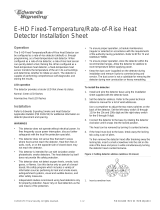Page is loading ...

© 2013 UTC Fire & Security. All rights reserved. 1 / 2 P/N 3101197 • REV 02 • REB 28JAN13
E-ISO Analog SLC Fault Isolator Module
Installation Sheet
Operation
The module is an analog addressable device used to protect a
Class A SLC from total collapse due to wire-to-wire short
circuits. The module monitors line voltages and opens the SLC
when a short is detected. A short is isolated between the two
modules located electrically closest to the short.
The device address is set using the two rotary switches located
on the front of the module. One device address is required.
LED operation
The module provides a bicolor LED that shows its status.
Normal: Green LED flashes
Active: Red LED flashes
Installation
WARNINGS
• This module will not operate without electrical power. As
fires frequently cause power interruption, you should
discuss further safeguards with your local fire protection
specialist.
• This module does not support conventional smoke
detectors.
Note: The module is shipped from the factory as an assembled
unit; it contains no user-serviceable parts and should not be
disassembled.
To install the module:
1. Verify that all field wiring is free of opens, shorts, and
ground faults.
2. Make all wiring connections as shown in “Wiring.”
3. Set the module address as follows:
Use a screwdriver to adjust the two rotary switches on the
front of the module. Set the TENS rotary switch (0 through
12) for the 10s and 100s digit and the ONES rotary switch
for the 0 through 9 digit. For example: device address 21,
set TENS rotary switch to 2 and set the ONES rotary
switch to 1.
Refer to “Specifications” for available address numbers.
4. Mount the module on the electrical box using screws
provided with the electrical box.
5. Mount the wall plate on the module using #4-24 x 1/2 in.
(13 mm) self-tapping screws.
Figure 1: Module address
Insert
screwdriver
here
Figure 2: Module installation
Screw
4-24
screws
Module
Wall plate
Compatible
electrical box

2 / 2 P/N 3101197 • REV 02 • REB 28JAN13
Wiring
Wire in accordance with NFPA 72 and CAN/ULC-S524. Be
sure to observe the polarity of the wires as shown in the
diagram.
Figure 3: Module wiring
From
previous
device
[3] [4]
[5]
To next
device
TB2
SLC OUT
SLC IN
(+)
(+)
( )
( )
( )
( )
Notes
1 For maximum wire resistance, refer to the appropriate manufacturer's documentation
2 Maximum 12 AWG (2.5 mm
2
) wire
[3] Refer to the control panel technical reference manual for wiring specifications
[4] This module should be used only with Class A wiring
[5] Maximum circuit resistance between isolators is 6 Ω
6 All wiring is power-limited and supervised
Specifications
Communication line voltage
Maximum 20.6 V peak-to-peak
Current
Standby
Activated
175 μA
200 μA
Ground fault impedance
10 kΩ
Maximum
circuit resistance
between isolators
6 Ω
Operating environment
Temperature
Humidity
32 to 120° F (0 to 49° C)
0 to 93% RH, noncondensing at
90° F (32° C)
Storage temperature range
–4 to 140° F (–20 to 60° C)
Compatible electrical boxes
North American 4 inch square x
2-1/2 in. (64 mm) deep 2 gang box
Standard 4 in. square box 1-1/2 in.
(38 mm) deep
Wire size
12, 14, 16, or 18 AWG wire (2.5, 1.5,
1.0, or 0.75 mm
2
) (Sizes 16 and 18
AWG are preferred)
Module address
01 to 64 (64 point control panel)
01 to 127 (127 point control panel)
/





